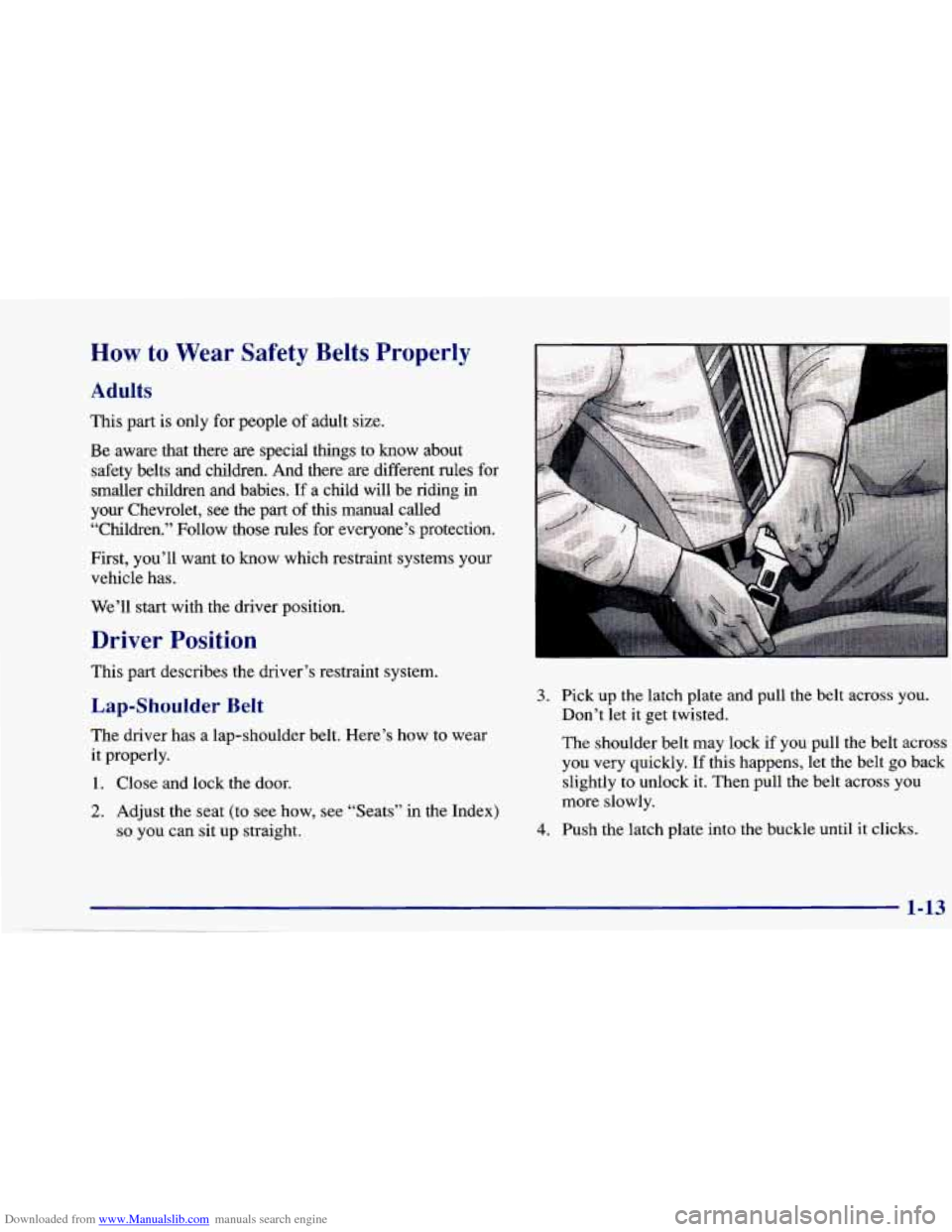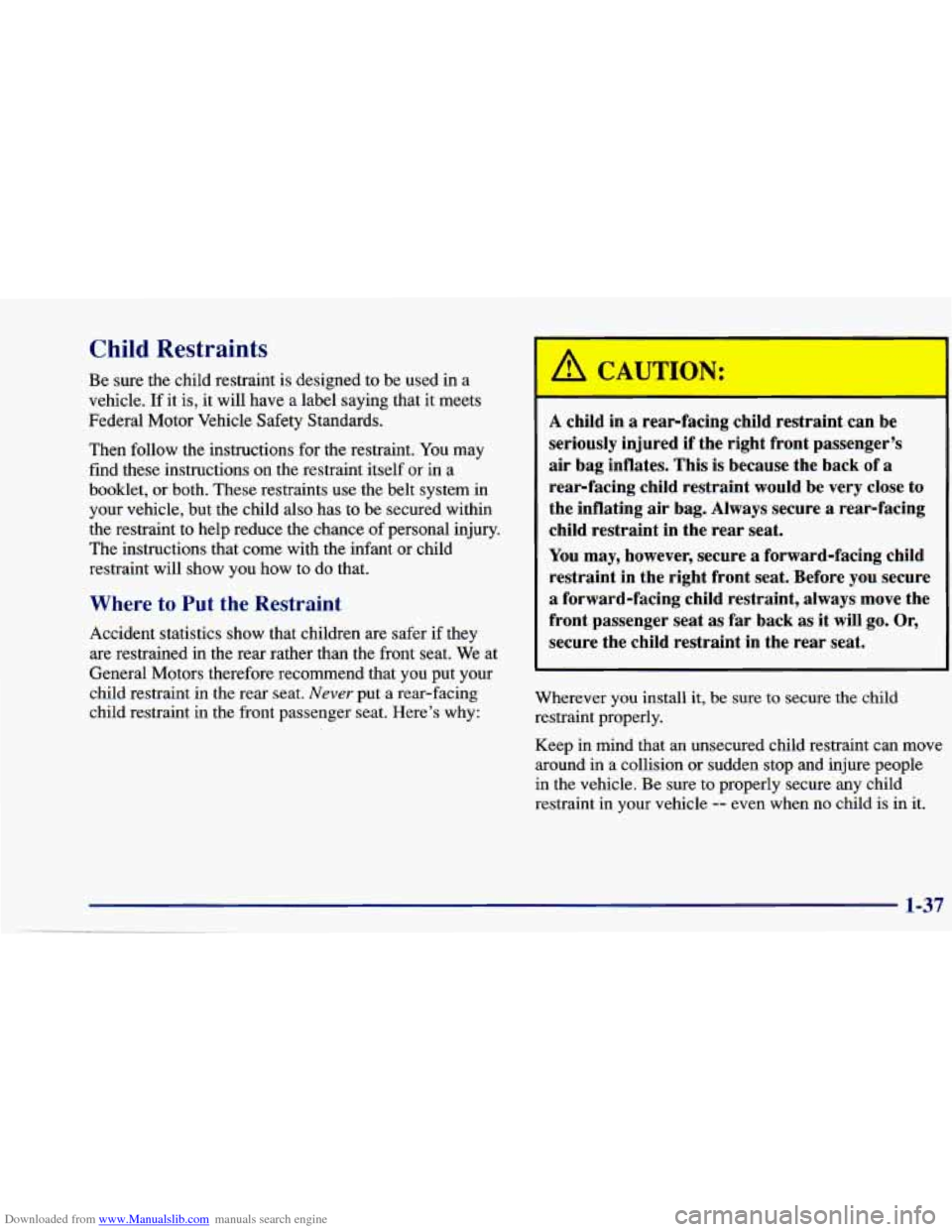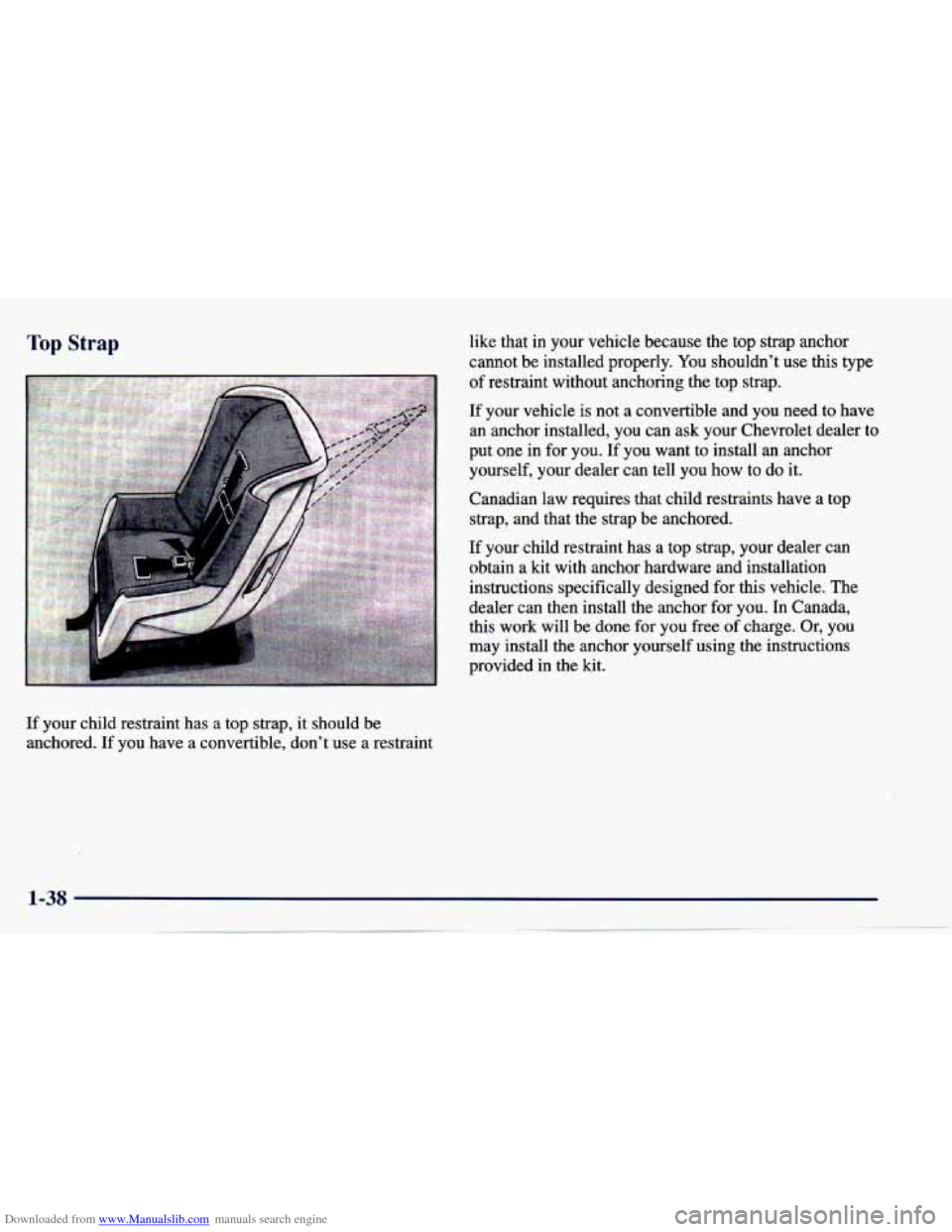Page 11 of 388
Downloaded from www.Manualslib.com manuals search engine Section 1 Seats and Restraint Systems
Here you’ll find information about the seats in your Chevrolet and how to use your safety belts properly. You can also
learn about some things you should nut do with air bags and safety belts.
1-2
1-7
1-12
1-13
1-13
1-21 1-22
1-22
1-28 Seats
and Seat Controls
Safety Belts: They’re for Everyone
Here Are Questions Many People Ask About
Safety Belts
-- and the Answers
How to Wear Safety Belts Properly
Driver Position
Safety Belt Use During Pregnancy
Right Front Passenger Position
Supplemental Restraint System (SRS)
Rear Seat Passengers 1-3 1
1-33 1-35
1-37
1-45
1-48
1-48 1-48 Rear Safety
Belt Comfort Guides for Children
and Small Adults
Center Passenger Position
Children
Child Restraints
Larger Children Safety Belt Extender
Checking Your Restraint Systems
Replacing Restraint System Parts After
a Crash
1-1
Page 23 of 388

Downloaded from www.Manualslib.com manuals search engine How to Wear Safety Belts Properly
Adults
This part is only for people of adult size.
Be aware that there
are special things to know about
safety belts and children. And there are different rules for
smaller children and babies.
If a child will be riding in
your Chevrolet, see the part
of this manual called
“Children.” Follow those rules for everyone’s protection,
First, you’ll want to know which restraint systems your
vehicle has.
We’ll start with the driver position.
Driver Position
This part describes the driver’s restraint system.
Lap-Shoulder Belt
The driver has a lap-shoulder belt. Here’s how to wear
it properly.
1. Close and lock the door.
2. Adjust the seat (to see how, see “Seats” in the Index)
so you can sit up straight.
3. Pick up the latch plate and pull the belt across you.
Don’t let it get twisted.
The shoulder belt may lock if
you pull the belt across
you very quickly. If this happens, let the belt go back
slightly to unlock it. Then pull the belt across you
more slowly.
4. Push the latch plate into the buckle until it clicks.
1-13
Page 41 of 388
Downloaded from www.Manualslib.com manuals search engine To unlatch the belt, just push the button on the buckle.
Rear Safety Belt Comfort Guides for
Children and Small Adults
Rear shoulder belt comfort guides will provide added
safety belt comfort for children who have outgrown
child restraints and
for small adults. When installed on a
shoulder belt, the comfort guide pulls the belt away
from the neck and head.
1-31
Page 45 of 388
Downloaded from www.Manualslib.com manuals search engine Children
Everyone in a vehicle needs protection! That includes
infants and all children smaller than adult size.
In fact,
the law in every state in the United States
and in every
Canadian province
says children up to some age must be
restrained while
in a vehicle.
Smaller Children and Babies
A CAUTION:
-
Smaller children and babies should always be
restrained in
a child or infant restraint. The
instructions for the restraint will
say whether
it
is the right type and size for your child.
CAUTION: (Continued)
A very young child’s hip bones are so small that a
regular belt might not stay low on the hips, as it
should. Instead, the belt will likely be over the
child’s abdomen. In
a crash, the belt would apply
force right on the child’s abdomen, which could
cause serious or fatal injuries.
So, be sure that
any child small enough for one
is always properly
restrained in a child or infant restraint.
1-35
Page 47 of 388

Downloaded from www.Manualslib.com manuals search engine Child Restraints ’
A CAUTION:
A child in a rear-facing child restraint can be
seriously injured if the right front passenger’s
air bag inflates. This is because the back of
a
rear-facing child restraint would be very close to
the inflating air bag. Always secure
a rear-facing
child restraint in the rear seat.
You may, however, secure a forward-facing child
restraint in the right front seat. Before you secure
a forward-facing child restraint, always move the
front passenger seat
as far back as it will go. Or,
secure the child restraint in the rear seat.
Be sure the child restraint is designed to be used in a
vehicle.
If it is, it will have a label saying that it meets
Federal Motor Vehicle Safety Standards.
Then follow the instructions for the restraint. You may
find these instructions on the restraint itself or in a
booklet, or both. These restraints use the belt system in
your vehicle, but the child also has to be secured within
the restraint to help reduce the chance
of personal injury.
The instructions that come with the infant
or child
restraint will show you how to do that.
Where to Put the Restraint
Accident statistics show that children are safer if they
are restrained in the rear rather than the
front seat. We at
General Motors therefore recommend that you put your
child restraint
in the rear seat. Never put a rear-facing
child restraint in the front passenger seat. Here’s why: Wherever you install
it, be sure to secure the child
restraint properly.
Keep in mind that an unsecured child restraint
can move
around in a collision or sudden stop and injure people
in the vehicle. Be sure to properly secure any child
restraint in
your vehicle -- even when no child is in it.
1-37
Page 48 of 388

Downloaded from www.Manualslib.com manuals search engine Top Strap
If your child restraint has a top strap, it should be
anchored. If you have
a convertible, don’t use a restraint like
that in your vehicle because
the top strap anchor
cannot be installed properly. You shouldn’t use this type
of restraint without anchoring the top strap.
If your vehicle is not a convertible and you need to have
an anchor installed, you can ask your Chevrolet dealer to
put one in for you. If you want to install an anchor
yourself, your dealer can tell you how to do it.
Canadian law requires that child restraints have a top
strap, and that the strap be anchored.
If your child restraint has a top strap, your dealer can
obtain a kit with anchor hardware and installation
instructions specifically designed for this vehicle. The
dealer can then install the anchor for you. In Canada,
this work will be done for you free
of charge. Or, you
may install the anchor yourself using the instructions
provided in the
kit.
Page 49 of 388
Downloaded from www.Manualslib.com manuals search engine Securing a Child Restraint in a Rear
Outside Seat Position
U
You’ll be using the lap-shoulder belt. See the earlier part
about the top strap
if the child restraint has one.
1. Put the restraint on the seat. Follow the instructions
for the child restraint.
2. Secure the child in the child restraint as the
instructions say.
3. Pick up the latch plate, and run the lap and shoulder
portions of the vehicle’s safety belt through or
around the restraint. The child restraint instructions
will show you how. Tilt the
latch plate to adjust the belt
if needed.
If the shoulder belt goes in front of the child’s face or
neck, put it behind the child restraint.
1-39
Page 50 of 388
Downloaded from www.Manualslib.com manuals search engine 4. Buckle the belt. Make sure the release button is
positioned
so you would be able to unbuckle the
safety belt quickly if you ever had to.
5. To tighten the belt, pull up on the shoulder belt while
you push down on the child restraint.
6. Push and pull the child restraint in different
To remove the child restraint, just unbuckle the vehicle's
safety belt and let
it go back all the way. The safety belt
will move freely again and be ready to work for
an adult
or larger child passenger. directions to be sure
it is secure.
1-40